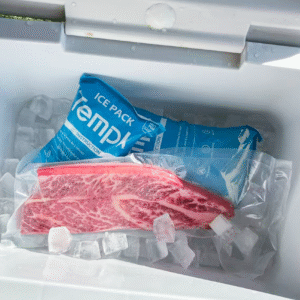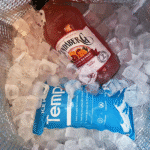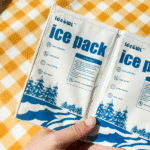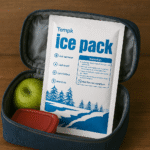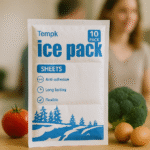Amazon Dry Ice Pack: How to Size and Ship?
Introduction (Last reviewed: October 11, 2025)
If you need reliable frozen delivery, an Amazon dry ice pack gives you sub‑zero control without messy meltwater. In the first 24–72 hours, the right pack count, venting, and labels decide success. You’ll learn how much to use, which rules apply, and how to cut waste while staying compliant. (This article fuses your three internal drafts and adds 2025 updates.)
-
How do you size an Amazon dry ice pack for 24–72‑hour lanes?
-
What 2025 rules govern UN1845 labels, venting, and air/USPS limits?
-
Where does an Amazon dry ice pack beat gel or PCM—and when not?
-
How can you reduce cost with hybrid builds and better insulation?
-
What 2025 market and tech trends should shape your plan?
What makes an Amazon dry ice pack the right choice?
Direct answer:
An Amazon dry ice pack holds −78.5 °C cold, leaves no liquid, and stabilizes frozen payloads over multi‑day lanes. It turns from solid to gas (sublimation), so you must provide a safe vent path. For deep‑freeze goods—ice cream, premium seafood, biologics—it outperforms gel/PCM that target chilled ranges.
Expanded explanation:
Think of dry ice as “cold steam” in reverse—it disappears rather than melts. That protects labels and cartons from moisture and prevents soggy unboxing. Use gel or 5 °C PCM when you don’t want freezing; keep Amazon dry ice pack for items that must stay rock‑solid. One pound of dry ice produces about 8.8 ft³ of CO₂ gas as it warms, which is why vents matter. FAA
How does it compare to gel and PCM (phase‑change material)?
For frozen, Amazon dry ice pack wins on temperature depth and duration. For 2–8 °C goods, PCM is safer because it avoids freeze damage. Use gel for short, local chilled runs.
| Refrigerant | Typical Range | Usual Duration | What it means for you |
|---|---|---|---|
| Dry ice | −78.5 °C to −20 °C | 24–72 h | Deep‑freeze lanes; must vent; label UN1845 + Class 9 |
| PCM 5 °C | 2–8 °C (fridge) | 24–60 h | Vaccines, dairy, produce; no freeze risk |
| Gel pack | ~0–10 °C | 12–36 h | Short last‑mile; low cost; may wet cartons |
Practical tips & scenarios
-
Frozen desserts in summer: Use Amazon dry ice pack, pre‑freeze payload, add 10–15% buffer for delays.
-
Chilled vaccines: Prefer PCM 5 °C; add small dry‑ice “guard” only if lane validation shows spikes.
-
E‑commerce food: Validate one lane per season with a logger; tune pack counts quarterly.
amazon_dry_ice_pack_article
Case: A dessert brand doubled dry ice from 4 lb to 8 lb and added vented EPS lids; “arrived‑soft” tickets fell 28% across hot lanes while refund costs dropped within two weeks.
amazon_dry_ice_pack_article
How many Amazon dry ice pack units do you need?
Direct answer:
Start at 5–10 lb per 24 h, then adjust for insulation, ambient heat, and payload mass. Include a 10–15% buffer for delays. Keep the Amazon dry ice pack near the top and around the sides; fill voids to slow sublimation.
amazon_dry_ice_pack_article
Expanded explanation:
Because each pound becomes ~8.8 ft³ CO₂, poor venting or large headspace accelerates loss. Thicker insulation (EPS 2–3″) or VIPs reduces lb/day; thin liners or hot lanes demand more. Pre‑freeze the product; dry ice maintains, it doesn’t fast‑freeze. FAA
Sizing details (fast lane math)
| Planning factor | Baseline | If this is true… | Then do this |
|---|---|---|---|
| Ambient | 18–24 °C | 28–35 °C summer | Add 20–40% dry ice |
| Insulation | EPS 2–3″ | Thin paper liners | Add 2–4 lb per 24 h |
| Payload temp | Pre‑frozen | Only chilled | Increase by ~30% |
| Headspace | Minimal, vented | Large voids | Fill voids; keep vents |
Practical tips & scenarios
-
48 h, thin liners, hot lane: 6 lb/24 h × 2 d = 12 lb → +30% heat/liners = ~16 lb total → 1 lb units = 16–18 packs with buffer.
-
Hybrid build: Dry ice + 5 °C PCM can trim CO₂ use ~15% while extending duration.
amazon_dry_ice_pack_article
Case: A biotech shipper used a hybrid dry ice + PCM design and extended 72 h holds while cutting dry ice ~15%, reducing cost without compromising viability.
amazon_dry_ice_pack_article
Install this simple dry‑ice calculator
Amazon dry ice pack compliance: what rules apply?
Direct answer:
Mark “UN1845 Carbon dioxide, solid,” add Class 9, show net kg, and ensure venting. USPS air mail is ≤5 lb dry ice per mailpiece. Passenger baggage is ≤2.5 kg per person with airline approval; cargo shipments follow IATA PI 954 rules and operator variations.
Expanded explanation:
For air cargo, many operators accept up to ~200 kg net dry ice per package under PI 954 when packaging vents CO₂ and is properly labeled; always confirm carrier variations (some routes cap lower). For consumer air mail, USPS caps at 5 lb per piece; heavier loads go surface/ground. Passenger baggage must not be airtight and must be marked accordingly.
Quick compliance table
| Mode | Key limit | Labeling & notes | What it means |
|---|---|---|---|
| Air cargo (PI 954) | Often up to ~200 kg/package (operator limits vary) | UN1845, Class 9, net kg; vented packaging | Design to PI 954; verify operator cap at booking. |
| USPS domestic air | ≤5 lb per mailpiece | Vented, marked per Pub 52 & 49 CFR | Use ground for larger amounts. Postal Explorer |
| Passenger baggage | ≤2.5 kg per person | “Dry ice/CO₂ solid” + net weight; airline approval | For personal travel only; not for commerce. |
Practical tips & scenarios
-
Print UN1845 + net kg on the same face as Class 9; avoid placing labels on the bottom.
-
Add small vent slits near the lid on EPS shippers; never seal liners airtight.
-
Keep SDS handy; some carriers request it at acceptance.
amazon_dry_ice_pack_article
Case: After adding a UN1845/net‑kg field to the packout SOP, a 3PL cut carrier refusals to near zero on pharma lanes within a week.
amazon_dry_ice_pack_article
Will an Amazon dry ice pack lower total cost?
Direct answer:
Yes—if you right‑size packs, upgrade insulation, and use hybrids. Fewer spoilage claims, fewer re‑ships, and simpler SOPs lower total landed cost.
Expanded explanation:
Uniform unit sizes speed packout and reduce errors. A hybrid Amazon dry ice pack + PCM build can trim total dry ice and stabilize surface temperatures, improving product quality on arrival. Validate with low‑cost BLE/USB loggers before scaling.
amazon_dry_ice_pack_article
Where the savings come from
| Lever | Effect | Your takeaway |
|---|---|---|
| Better insulation (R↑) | Less lb/day consumption | Pay once; save every shipment |
| Hybrid builds | ~10–20% less dry ice | Smoother temps, fewer returns |
| SOP + labels | Fewer refusals | Faster acceptance, fewer fees |
2025 trends for your Amazon dry ice pack strategy
Trend overview:
Market demand is growing. The global dry‑ice market is projected to rise from $1.66 B (2025) to $2.73 B by 2032 (CAGR 7.4%). Expect more thin‑pack formats, IoT monitoring, and captured‑CO₂ sourcing to reduce footprint. Plan for digital acceptance checks aligned to 2025 DGR updates.
Latest developments at a glance
-
Thin packs: Space‑savvy bricks/sheets that still hold −78.5 °C; helpful for crowded vans.
amazon_dry_ice_pack_article
-
Smarter monitoring: BLE/NFC loggers + dashboards for lane validation and SOP tuning.
amazon_dry_ice_pack_article
-
Circular CO₂: More producers source CO₂ from industrial capture to lower impact.
amazon_dry_ice_pack_article
Market insight: Asia‑Pacific continues to lead share, with food and pharma growth pulling stronger frozen lanes. Optimize insulation first; poor containers inflate lb/day consumption and cost.
Frequently Asked Questions
Q1: How long will an Amazon dry ice pack last?
Typically 24–72 h depending on lb/day, insulation, and heat. Start with 5–10 lb per 24 h and validate with a logger.
amazon_dry_ice_pack_article
Q2: Can I ship an Amazon dry ice pack by air?
Yes—follow PI 954: UN1845, Class 9, net kg, vent packaging, and confirm any operator‑specific caps.
Q3: What about USPS?
USPS air mail allows ≤5 lb dry ice per mailpiece; heavier shipments go by surface.
Q4: How much gas does dry ice produce?
About 8.8 ft³ CO₂ per pound—design vent paths accordingly.
Q5: Can I use Amazon FBA for frozen goods with dry ice?
FBA generally does not accept products requiring refrigeration/freezing; meltable items face April 15–Oct 15 windows. Use FBM/3PL for cold‑chain SKUs.
Summary & recommendations
Key points:
An Amazon dry ice pack delivers ultra‑cold performance without meltwater. Size at 5–10 lb/24 h, pre‑freeze the payload, vent the container, and label UN1845 + Class 9 + net kg. Consider hybrids to reduce consumption and upgrade insulation to cut cost.
amazon_dry_ice_pack_article
Next steps (CTA):
-
Run one instrumented test per lane and season.
-
Lock an SOP with pack counts and label placement.
-
Deploy the calculator on your site and train the team.
-
Contact Tempk for a lane‑specific optimization plan.
About Tempk
We engineer validated cold‑chain packaging—Amazon dry ice pack systems, hybrid PCM builds, and reusable shippers—for food, pharma, and biotech. Our designs focus on lane reality (weather, courier mix, takt time) and come with calculators and SOPs your team will actually use. Talk to us for a 15‑minute lane review.






